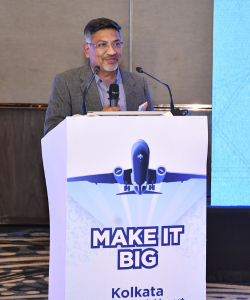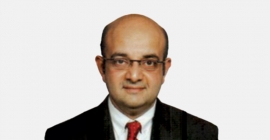‘Digitisation, transit infra expansion, automation: key growth drivers’
By Rajiv Raghunath - August 14, 2023
Shekhar Narayanaswami, President, Times OOH shares his thoughts on Indian OOH’s transformative journey and the way forward in an interview with Rajiv Raghunath.
 You have had a very successful stint in the OOH industry, working with Times OOH which has in many ways defined the contours of Indian OOH landscape. What discernible changes you have witnessed in the Indian OOH industry over the last 7-8 years?
You have had a very successful stint in the OOH industry, working with Times OOH which has in many ways defined the contours of Indian OOH landscape. What discernible changes you have witnessed in the Indian OOH industry over the last 7-8 years?
In the last 7-8 years, the Indian OOH industry has undergone a remarkable transformation, characterised by paradigm shifts in advertising mediums and a redefinition of the supply landscape by media owners. One notable area of change has been the transit segment.
India's metro rapid transit system is experiencing rapid growth. With 859 kilometres of operational metro lines, India boasts the fourth-longest metro network in the world, trailing behind China, the US, and South Korea. Furthermore, several metro lines are currently under construction or in the planning phase. The expansion of urban rail systems not only enhances connectivity but also offers advertisers increased dwell time and urban media advertising opportunities.
In 2023, the Airport Authority of India finalised the privatisation of 25 additional AAI-owned airports, leasing them to private companies. This move extends airport advertising to newer Tier I & II cities, providing more planned and premium advertising options. Projects such as the Ahmedabad Smart City initiative are introducing digital media to the country's roads, adding a new dimension to the industry.
There has been a significant improvement in the level and quality of digitisation. Both metro and non-metro cities now possess digital inventories, allowing advertisers to showcase dynamic content at cost-effective rates. This progress has been made possible through the positive regulation of OOH by concerned. Authorities are now designing tenders keeping OOH media nuances in mind, including longer tenures and a less fragmented approach. They are also actively involving OOH and the concessionaires in the process by seeking suggestions, feedback, and reviews. This proactive approach is a major growth driver for the industry.
Acceptance from brands is pivotal to these advancements. Advertisers are progressively gravitating towards premium touchpoints and long-term bookings, demonstrating their willingness to pay a commensurate price. This acceptance instils confidence among industry players, fostering investment in superior-quality assets.
Measurement has long been a stumbling block; however, we are working with leading firms and along with IOAA, we have taken several initiatives to address this issue, yielding some positive outcomes. Nevertheless, there is still a long way to go, and progress is ongoing. Another challenge that persists in the industry is the presence of unorganised practices, which can hinder business growth. Nevertheless, efforts have been made to control these practices over time, and there is optimism that they will be eradicated from the industry soon.
In more recent years, and particularly in the post-Covid period, Indian OOH is seeing accelerated digitalisation of the business and media. Do you see industry wide shift to DOOH media, and how sustainable is the DOOH growth in the Indian setting?
If one has to find a silver lining in the COVID-19 period, it is undoubtedly the advent of digitisation of Indian OOH media. According to the PMAR 2023 report, there has been a significant surge in the number of digital inventories in the country. DOOH screens have grown from 26,940 in 2020 to 57,690 inventories in 2021 and 89,700 in 2022. At Times OOH, we own a portfolio of 1,400+ digital media assets across various touchpoints, ranging from small to large formats.
Not only have the numbers increased, but the avenues for DOOH have also expanded beyond airports to include medical centres, retail outlets, and cafes.
The growth of DOOH is driven by two key factors: authorities and advertisers. We are pleased to state that authorities have recognised the significance of DOOH media. As an example, Times OOH is handling the largest DOOH city-level deployment in the country in Ahmedabad, which comprises 128 digital billboards. This has transformed the face of the city and given brands a unique proposition to engage with the daily commuters. Additionally, we have witnessed a tremendous surge in digital assets in Mumbai, Kolkata, and other cities.
Clients are experimenting more with interactive and engaging content, displaying multiple creatives simultaneously, Certain categories, such as luxury brands, find DOOH to be the best-suited format for their promotion and product placement. Moreover, as more global brands venture into India, we anticipate an increased demand for the digital outdoors,
Furthermore, we have observed that new advertisers are testing OOH by making their maiden investments in DOOH. This helps them to gain experience and exposure at highly cost-effective rates compared to static media.
The OOH industry is undergoing a significant digital transformation as media owners are embracing the transition from traditional billboards to digital formats. Ad buyers, media agencies, media owners, and ad technology vendors are also embracing the transformation. The advent of programmatic DOOH (pDOOH), with its enhanced advertising capabilities, is set to propel the growth rates of DOOH. By enabling brands to effectively engage with their target audience at precisely the right moments, occasions, and durations, pDOOH significantly boosts the visibility and engagement levels, amplifying the likelihood of capturing attention and fostering increased audience involvement.
Transit media has contributing significantly to Indian OOH growth. As the transit infrastructure expands across the country, do you see more advertising avenues being created or will that result in an overkill or over-supply of media?
Transit media is nothing short of a boon for the Indian OOH industry, thanks to its organised media, premium audience, and high dwell time. When it comes to the audience, the new generation seeks smart travel options, such as metros and by air, which offer better amenities, convenience, and enhanced connectivity. Therefore, there is no doubt about the ROI of investing in transit avenues from the perspective of both media owners and advertisers.
Furthermore, there is no shortage of advertisers in India, as it is a growing market with new companies emerging, offering various solutions, products, and services. These are new-age brands operated by young entrepreneurs who understand the significance of the OOH medium. Thus, there will never be an oversupply of the medium. Additionally, we have observed that formats like metro media and Tier II airports are widely utilised by regional advertisers, with each city having its own set of clients leveraging these spaces.
Indian OOH has not been able to adopt a common currency for audience metrics. Is that curbing the industry’s growth prospects or can OOH achieve higher growth without those metrics?
When the industry comes together and adopts a common language, it creates a significant impact on external stakeholders and concessionaires. By utilising proper metrics, performance figures, and ROI data, the industry can attract more clients and secure a larger share of the advertising budget.
At Times OOH, we successfully serve our clients by providing actual numbers of airport and Metro passengers, which justifies their spending and helps them calculate their exposure to the audience. In addition to transit touchpoints, we offer various mechanisms to provide metrics to clients, easing their quest for ROI. For example, Times OOH has invested in high-end software that perfectly measures exposure on our city media assets.
Moreover, several other factors can contribute to the growth of the industry, including organised practices, premium quality assets, and increased engagement levels.
Looking ahead, what factors will help Indian OOH businesses to scale up? Is consolidation the way for the industry to gain a larger share of the ad pie?
Consolidation has been a key factor in the growth of many industries. However, the OOH industry is vast, encompassing a variety of formats, avenues, and operating mechanisms. Therefore, achieving consolidation may take some time to bring everything together and treat them uniformly. Nevertheless, it is important and should happen for the industry's transformation, even if it requires an extended period.
Understanding the clients' mindset is crucial to provide effective, dynamic, and result-oriented solutions. By "result-oriented," we refer not only to ROI but also to interactions, interactivity, or some level of engagement that establishes a foundation for their spending and further enhances their growth in the medium.
Therefore, I believe that the rapid evolution of digitisation, the expansion of transit media, and the implementation of programmatic DOOH will drive industry growth in the coming years by offering improved solutions to advertisers.

Stay on top of OOH media trends








